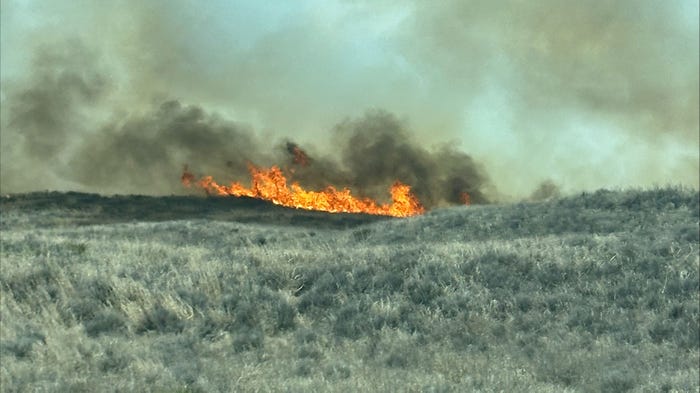
Denise Finlay was driving on Kansas Highway 25 just south of Lakin, Kan., on her way to Ulysses, Kan., on Feb. 26 when she saw the first emergency vehicles.
“I had a hay truck in front of me, so I couldn’t see a lot,” she said. But she could see big plumes of smoke, and considering the high winds and dry conditions in the county, she became concerned.
“We had just had a fire on Friday in northern Hamilton County at a farm, and the house was saved, but [the farmer] lost some antique cars he had in some sheds,” Finlay explained.
So, the area’s rural firefighters were all on high alert for conditions to spark more fires through the next week.
Finlay said the fire was close to the highway, and she and other vehicles moved along for more than a mile watching firefighters assisted by airplanes fight the flames. She said at first, she couldn’t tell where the smoke was coming from, and she was concerned it might have been a dairy or large livestock operation, but as the line of traffic got closer, it became clearer it was brush and pasture.
Weather reports for the area had wind speeds out of the west-northwest of 25 mph, with gusts at times up to 40 mph. “My vehicle was rocking from the wind as we sat there,” Finlay said.
Kearney County Emergency Services posted on its Facebook page late Feb. 26 that the fire south of Lakin was extinguished, with the assistance of local farmers who brought disks to break out ground in front of the flames, Grant County Fire, Stanton County Fire, Garden City Fire, Tri-Rotor Crop Services, and the Kansas Forest Service. Other unofficial reports said that one house that was lost, and one person was injured.
The Wichita news station KSN reported that there were other fires that sparked throughout the state on Monday in Seward, Sumner, Stafford, Reno, Kingman, Rice and McPherson counties.
According to the Kansas Adjutant General, Kansas Gov. Laura Kelly issued a verbal state of disaster emergency proclamation the morning of Feb. 26 because of increased fire weather conditions that were expected through the rest of the week. The declaration allows the use of state resources for assistance.
Warmer temperatures, strong winds and low relative humidities are a perfect combination for high fire weather conditions.
Rodney Redinger, assistant fire management officer for the Kansas Forest Service, warned Kansans to avoid activities that could cause sparks, such as welding or using cutting torches. And, if they can’t be avoided, make sure a fire extinguisher, water pressure can or other extinguishing tool is handy to put any fire out that might ignite, he said.
Weather reports from around the state were cautioning Kansans to be on alert for more fire dangers through the rest of the week. Local fire departments and emergency responders will be monitoring the situation, and the Kansas Division of Emergency Management is staffing the State Emergency Operations Center to assist counties and local responders if requested, according to the Adjutant General’s Office.
People helping people is how Kansans get through tough situations, Finlay said.
“Time like these are devastating but also comforting as we are reminded about the great people in the communities we live in, and how people don’t hesitate to help out and assist,” Finlay said.
Fireproof your home and farmstead
“During a major fire, one of the challenges is that there are not enough fire trucks for every home,” says Eric Ward. “It’s just a given that if there’s a major fire coming, there will not be a fire truck at your house. There just aren’t enough in any community.”
Ward, assistant fire manager for Kansas Forest Service, spoke to K-State Research and Extension News Service in February. He offered important tips for homeowners and farmers to take to fireproof their properties considering the probability of wildfires this spring, and the limited resources available for immediate response.
These can be found in the Kansas Forest Service publication, “Ready, Set, Go! My Personal Wildland Fire Action Plan.” The tips include:
Move firewood away from the side of the house.
Clean roofs and gutters of dead leaves, debris and pine needles.
Replace or repair loose or missing shingles on the roof.
Prune tree branches so they are at least 10 feet from the home’s roof.
Keep lawns, native grasses and wildflowers at a height of less than 4 inches.
Keep trailers, recreational vehicles, storage sheds and other combustible structures more than 30 feet away from the home.
Kansans should also bookmark the Forest Service’s Wildfire Risk Assessment portal available online. The new and free tool offers an assessment of fire risk in the area of an address using 34 datasets.
Additionally, the Kansas Mesonet offers its online “Kansas Fire Danger Forecast” tool.
Chip Redmond, director of Kansas Mesonet, says it’s important to use the seven-day capability of the tool to make sure farmers are checking any fires for reignitions after the original burns.
About the Author(s)
You May Also Like






